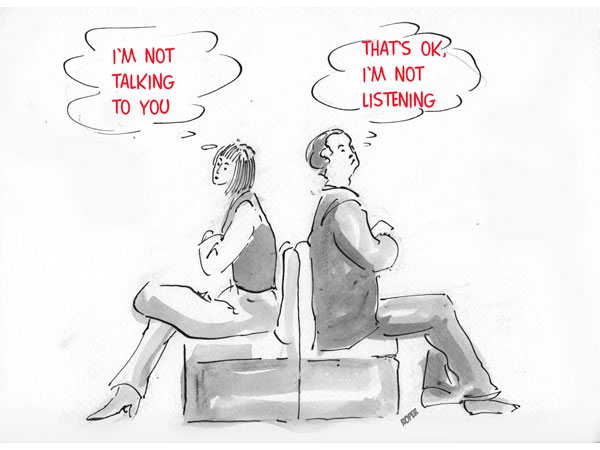Most people do not listen with the intent to understand; they listen with the intent to reply.
Stephen R. Covey
How well do you listen? Have you in fact ever thought about whether there is any way to listen other than the one that comes naturally to you?
Something like this?
You: “What did you do at the weekend?”
Them: “I went hang-gliding.”
You: “Wow, that’s interesting. I went ballooning.”
Them: “Yes, I loved the feeling of being out in the open air and up high, so you can see everything.”
You: “Oh, so did I. Ballooning’s great for that – you can see for miles.”
Them: “Well, hang-gliding’s great for that too – and you can control where you’re going…”
Can you see what’s happening? You asked them what they did at the weekend, and every time they try to tell you, you talk about what you did.
It’s almost as if people are having parallel monologues. They’re not listening to the other’s point of view, they’re just waiting for them to take a breath, so they can share theirs.
They’re on the same track, but on separate rails – fairly close, but never together, stretching into the distance but never meeting.
So what’s the alternative?
It begins with a mindset shift. The prevailing mindset goes something like, “I’m in this conversation to get my ideas and thoughts across. I’ll wait for the minimum respectable amount of time (not everybody even does this, by the way) and then say my bit.”
A more productive mindset is, “For at least half of this conversation, I’m going to really listen to what they are saying and set aside my own opinions.”
The feeling is one of choosing to get off your rail for a specific period of time and go and sit with them on theirs. Listen to the conversation now:
You: “What did you do at the weekend?”
Them: “I went hang-gliding.”
You: “Wow, that’s interesting. What was that like?”
Them: “Oh, I loved the feeling of being out in the open air and up high, so you can see everything.”
You: “How did it feel?”
Them: “Well, a bit scary at first, but I quickly got so fascinated by what I could see that I forgot to be frightened.”
You: “Tell me more about what it was like…”
It may feel unnatural, but listening this way is far more likely to help them open up and tell you more. You might even learn something you didn’t know, if you stop listening to yourself preparing your response!
You will need to discipline your thoughts when they threaten to draw you off the other person’s rail onto your own. At first, you may only do this for very short periods of time. but you can train yourself to listen more actively – perhaps when you are coaching or interviewing, or just want to build a better relationship.
Active listening
Asking questions, surprisingly, doesn’t necessarily make you a good listener. If you think about it, asking questions is actually coming from your own track – you are thinking about what you need to know and what information you’d like to find out. So how can you listen actively, and stay with them on their track?
Well, reflect back to them what they have said. Ask a question to get them going, then as they begin to speak, each time they pause for breath, confirm what they have said by repeating it back to them, as closely as possible in their own words.
It may feel a little odd, but I promise you, most people are so delighted to know you really got what they said that they’ll just rush on with the next thing they wanted to say. You’ll know you got it right, if after each time you repeat back their words to them, they say, “yes, and….” and they’re off again.
Interrupting…
If they never seem to take a breath, and you get worried that you won’t be able to remember it all accurately, this is the one time it’s OK to interrupt. Usually, we interrupt to drag someone off their track onto ours, and this is perceived as irritating and rude. If, however, you interrupt to help someone clarify their thoughts or expand on something they’ve said, they’ll find it actively helpful.
A good tip if you find this difficult is to use phrases like, “So if I understand you, what you are saying is…”, or, “Let me see if I’ve got exactly what you’re saying. You said…” You can also say, “Tell me more…”, or, “Go on…”
You’ll find people won’t mind being interrupted to hear their own words fed back to them. They’ll know you are really trying to understand and will find it flattering and empowering. Very few of us have the experience of being listened to properly by others, and it’s refreshing when we do.
Some hints:
- Having made the choice to listen, use appropriate body language: lean in, make eye contact, and encourage them by nodding and smiling.
- Make noises, especially if listening on the phone. It’s very disconcerting talking into a vacuum – you need to make it clear you are listening even though you are not chipping in.
- Hold off questioning for as long as possible. Appropriate body language, encouraging noises and reflecting will keep a person going longer than you would think possible.
- If you do use questions, keep them as open as possible. Questions beginning with ‘how’, ‘why’ and ‘what’ tend to lead to more open responses than ‘yes/no’ questions and ones beginning with ‘who’, ‘when’ and ‘where’.
Give it a go – they’ll love the attention and your relationships will benefit. This is one time when practising on other people can really be justified…!
